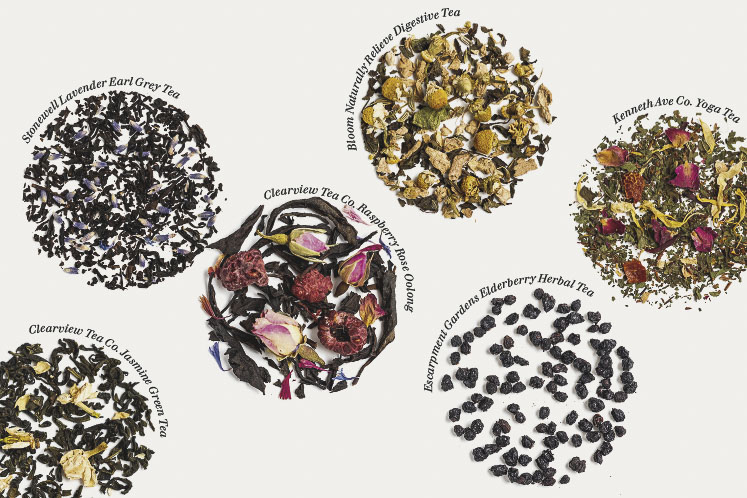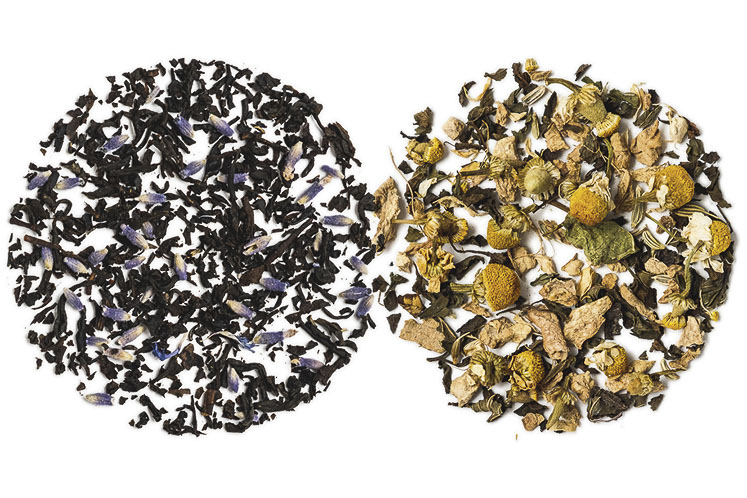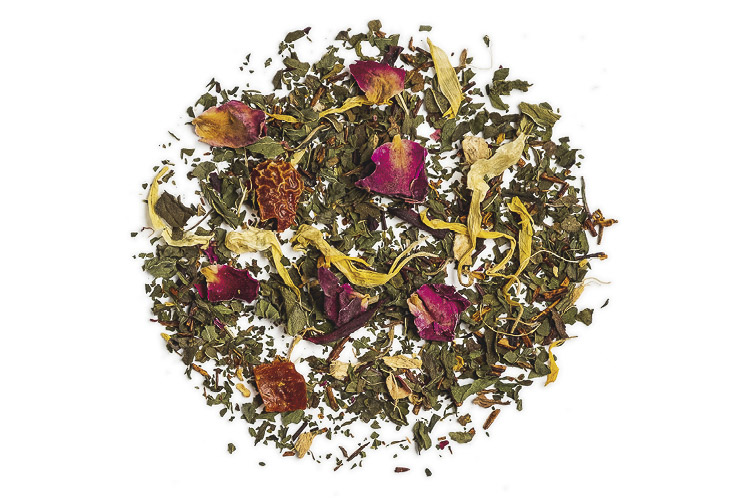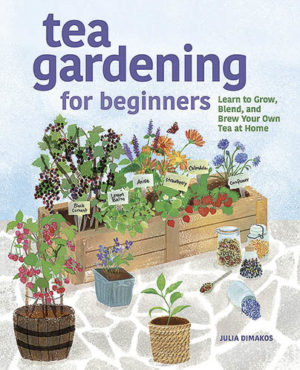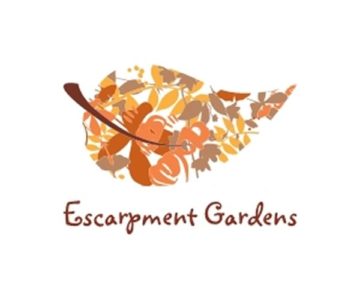Our Cup of Tea
How local tea lovers are growing and reimagining an ancient drink for modern times
There are no plowed fields, bank barns or other signs of traditional farming on Joey Lemieux’s Mono property, but like many of his neighbours, Joey has been planting, tending and harvesting crops for years. Instead of potatoes or soy, however, he grows and forages plants and fungi from his natural meadows and woods to make herbal teas.
Joey’s line of more than 50 teas includes ingredients such as the “heal-all plant” (Prunella vulgaris), wild bergamot and chaga mushrooms – all of which he dehydrates and tucks into unbleached wood pulp tea bags to sell under his Escarpment Gardens label at the Orangeville Farmers’ Market, online and in local shops. Joey’s teas meet the standards of the New Jersey-based Certified Naturally Grown group and he is working toward organic certification.
“This year we’re planting hundreds more birch trees, which chaga grows on, so that our chaga harvest can be even more sustainable in the future,” says Joey, who leaves about an inch of each mushroom behind on the tree to reproduce. The superfood, known for its antioxidant properties, stars in his Chaga Chai. Other offerings include Cedar Pine and Lemon Pear, the latter mimicking a first bite into juicy fruit.
Joey has been producing herbal teas – or tisanes; some purists will say only black tea is tea, so tisane is the correct term – in Mono since 2015. He’s part of a small but dedicated industry of local growers and purveyors who have created enough herbal, black and other tea blends to keep us all brewing for years. Fellow Mono tea lover and gardening expert, Julia Dimakos, captures the momentum in her recently released DIY guide called Tea Gardening for Beginners, with tips for planting, growing and drying tea ingredients.
For Joey growing, creating and drinking herbal tea go well beyond those acts themselves. “It can deepen our relationship with the natural world.” Indeed, whether you’re just reflecting on the landscape outside your window or getting your routine Earl Grey caffeine hit first thing in the morning, you’re tapping into a horticultural and cultural tradition dating back thousands of years to China. Black, oolong, white and green tea all derive from the leaves or leaf buds of two varieties of the Camellia sinensis plant and are left to oxidize for different lengths of time. Black tea is left to oxidize the longest, resulting in a rich flavour and longer shelf life, says Maggie Morrison of Clearview Tea Co., which she founded in Creemore in 2012 with her mother, Rebecca Brown.
The tea plant isn’t hardy enough to grow in our Zone 5, so professional and amateur tea growers focus on a range of other plants. Those who create blends based on black and other teas derived from Camellia sinensis source those tea leaves from Canadian and international growers. While Julia Dimakos does shares tips for growing Camellia sinensis in her new book (her publisher is in California, where it is possible to grow it outside), local readers can turn to more than two dozen other plants anyone with a sunny plot or windowsill can propagate.
Lavender is one of those plants showing up in local teapots, thanks to a mini-boom in lavender farms across Headwaters. At Stonewell Lavender Farm outside Erin, Lee Anne Downey has been creating teas using English lavender (Lavandula angustifolia) buds harvested from her fields since 2019. After being hung to dry for two weeks, the buds are separated from the stem and are ready to add to her ginger-peach, hibiscus-rosehip, and Earl Grey recipes. (For anyone concerned the flavour may be too floral, Lee Anne recommends steeping for a short time to start.)
“In the summertime we recommend an iced tea version made by steeping, removing the herbs and pouring over ice cubes.” Lee Anne also suggests various add-ons, including sparkling water and fruit syrup – for mocktails or even cocktails.
Grow your own
For those inspired by Joey and Lee Anne to nurture their own teas from the ground up, Julia’s guide is divided into sections on leaves, flowers, fruits and seeds, and roots commonly uses as teas. For her, growing these ingredients for tea was the next logical step as she tended to her family’s 7,000-square-foot kitchen garden. “I thought if I can grow my own food, why not grow plants that can be used for tea?” she says. “I started with mint and chamomile, and then increased from there. I expand my tea garden each year, adding new ingredients.”
Julia starts annuals such as roselle (also known as hibiscus), lemongrass, lemon verbena, holy basil and chamomile from fresh seeds each year. Mint, lemon balm, red clover, anise hyssop, sweet violets and strawberries are perennials and have no trouble growing in our climate. Julia has an orange tree that she grows indoors all winter, and then moves outside for the summer. “With some creativity you can grow just about anything,”
If starting plants from seed, Julia recommends doing so indoors in January or February to give them a head start on spring, placing them under a grow light or in a sunny southwest-facing window. Starter plants can be purchased at a nursery too. Her one major caveat: “I recommend growing mint in a large pot or it will take over your garden. Or, if you have the space, designate a garden for it and let it run free.”
Julia dries plant material for anywhere from 12 to 24 hours in a dehydrator, set at a low temperature for leaves or flowers, or higher for plants that contain a lot of moisture, like fruit and roots. Another option is to hang the leaves to dry or lay them out on drying racks. This method is not recommended for fruit as it may attract insects or start to mould.
After those steps, the tea is ready. So, what flavours does Julia reach for? “I prefer to create tea blends on the go, based on my mood, or what I’m hoping to get from the tea. If I’m looking for an energy boost, I like to create a tangy, lemony tea or a refreshing blend with mint. If I’m feeling under the weather, I choose more medicinal plants. I rarely drink a single herbal tea.”
A wellness drink
For some, like Joey, those medicinal properties are what drew them to tea production. Joey sees himself as part of an ancient and enduring practice. “Throughout history people have steeped plant material in hot water,” he says, “with a belief in its power to improve many physical and emotional issues without side effects.”
For instance, he says, ginger is known to ease stomach upset, hibiscus may help safely lower blood pressure, and mullein leaf is recommended to alleviate upper respiratory congestion.
Mikayla Stinson, who founded Kenneth Ave Co. in 2020, says the healing potential of tea inspired her foray into the business. “When I was growing up in Erin and dealing with stomach issues, my Oma used to always make me a cup of peppermint tea to soothe my stomach,” she says. “I hold those memories close to my heart.” Mikayla named her company after the street in Erin where her grandparents lived. And that mint now appears in her Yoga tea, along with rosehip, calendula and osmanthus petals.
Naomi Higenbottam, of Bloom Naturally in Caledon, is on the same wavelength. Her family’s British roots meant black tea was a household mainstay when Naomi was growing up. Now, as a lactation consultant, nurse and holistic nutritionist with an expertise in herbalism, she is a herbal tea booster.
Naomi developed her line in 2014 to support common conditions her clients faced such as gas, bloating, skin irritations and breast milk supply problems. Her most popular tea is the Relieve Digestive Tea, specially formulated to help soothe the stomach, reduce bloating and aid in digestion. A sip reveals strong notes of ginger and mint, with a hint of chamomile and fennel – the 100 per cent organic mix, sourced wholesale from Toronto’s Honest Leaf – is also visually appealing, evoking a field of wildflowers dotted with chamomile heads.
The pleasure purveyors
While all local tea makers offer herbal and soothing brews, many also dabble in playful culinary blends. Caledon’s Amanda Luthra crafts a range of savoury South Asian spice blends under her ChillyPaste brand – and she’s given the same level of care to her masala chai blend, which builds on Assam black tea leaves with 12 aromatic spices.
At Kenneth Ave Co., now headquartered in Guelph, black tea is a base for fanciful dessert flavours. “Our brand is about unique and fun blends of tea,” Mikayla says. Imagine the taste of cookie dough, birthday cake or caramel folded into a tannin-rich base tea. Custom and seasonal blends are also available – watch for one inspired by Cadbury Mini Eggs in spring. The company’s green tea lineup includes Mango Matcha and its rooibos, a reddish, smooth and naturally caffeine-free tea, is mixed with chocolate and caramel.
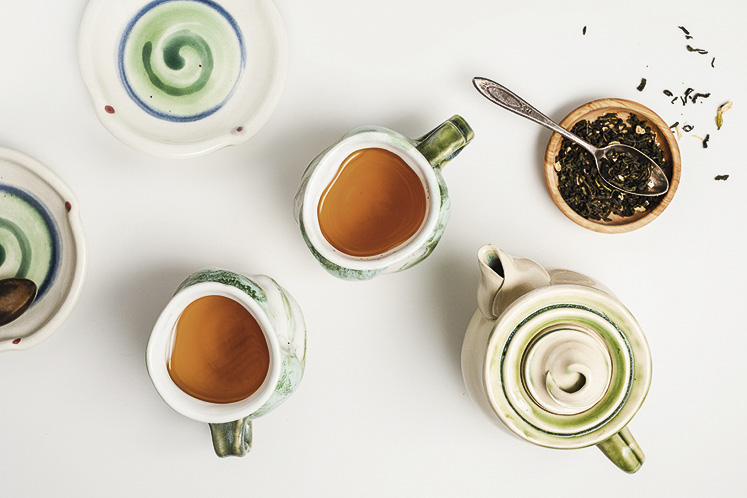
Tea for two with Clearview Tea Co.’s Jasmine Green Tea. Teapot, cups and saucers by Wendy Mitchell-Burke of Treehouse Pottery in Belfountain.
A similar penchant for alchemy is behind Maggie Morrison’s Clearview Tea Co. The company is best known for their Creemore Market Blend, a black tea with touches of vanilla and bergamot (the floral hit in Earl Grey) notes. Ivory Cable-Knit Sweater marries black tea with vanilla and pinky rose petals. Two years ago, they opened a tea and gift shop in Schomberg, complete with a blending room. Maggie and her husband, Ian Morrison, have largely taken over the business (after Rebecca decided to follow her passion and complete architecture school in Nova Scotia).
Like her fellow tea growers and blenders, Maggie can’t imagine a day without a steady supply of tea in near-infinite varieties. “Black tea is my favourite; I always start my day with it and switch to herbal teas or rooibos by the afternoon.
“Tea is so versatile, there is a tea for any mood.”
More Info
Steep Learning Curve
“Ever since I started growing my own herbs, I discovered there is more than one way to brew tea,” writes Julia Dimakos in her book Tea Gardening for Beginners.
Julia shares the following tips on black and herbal tea brewing. If you want to experiment with the slight temperature variations she suggests, consider using a standard or electric kettle with a built-in thermometer.
Read our review of Julia’s new book, and lots of other local reads, in our article The Year in Books: 2022.
GREEN TEA
Green tea can taste bitter if you steep for too long in too-hot water. Steep for less than a minute at 80C to 85C.
WHITE TEA
Steeping at 80C to 85C will result in a floral and fruity flavour. At 90C to 95C you’ll notice a woodsier flavour. Steep for three to four minutes.
OOLONG TEA
You want to brew oolong at a higher temperature, just below the boiling point, at 90C to 97C. Brew for one or two minutes.
BLACK TEA
At lower temperatures, 80C to 85C, the tea will be fruitier and lighter. At 90C to 100C you’ll get a more woody, spicy drink.
HERBAL TEAS DECOCTIONS
Place denser dried plant material like roots in a saucepan and cover with water. Bring to a boil, then simmer for at least 20 minutes.
INFUSIONS
Pour boiled water between 95C and 100C over dried leaves, flowers or fruit and steep for at least four or five minutes. Some plants contain tannins. Lowering the heat to between 90C and 94C, and steeping for five to 15 minutes, will prevent tannins from taking over.
COLD BREWING
Add two or three tablespoons of the tea blend to a large glass canning jar or pitcher. Fill to the top with water. Close the lid and place in the refrigerator. Leaves take at least eight hours, roots need 24 hours, and flowers, fruits and seeds fall somewhere in-between. This produces a sweet, gentle tea.
— ADAPTED FROM TEA GARDENING FOR BEGINNERS
Related Stories
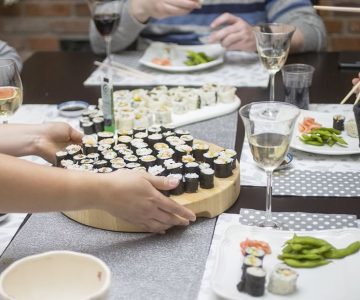
Food + Drink Winter 2019
Nov 22, 2019 | | Food + DrinkWinter’s savoury side: mobile sushi, chic tipples and go-to gourmet gifts.

